 |
||
|
||
| ||
TABLE OF CONTENTS
NVIDIA GeForce 7800 GTX 256MB PCI-E: Part 1: Theory and architecture
NVIDIA GeForce 7800 GTX 256MB PCI-E: Part 2: Video card's description, testbed configuration, synthetic test resultsIn the previous parts we have reviewed theoretical aspects of the architecture of the new NVIDIA's product. We have also reviewed the performance demonstrated by the GeForce 7800 GTX in synthetic tests (we have learned that pixel pipelines in the G70 are not just increased in number compared to the NV45, they are also overhauled, resulting in performance gain of each pipeline per unit of frequency; besides, the card has larger caches, which balance is slightly shifted towards more complex scenes in terms of geometry and textures). This part of the article contains the body of our analysis, which is interesting to all gamers - performance in real 3D games. Our first encounter with the GeForce 7800 GTX will be concluded with a brief comment on the AA quality (we have already mentioned the new AA mode in the GF7800GTX in the first part of the article). Test results: performance comparisonWe used the following test applications:
Game tests that heavily load pixel shaders 2.0.TR:AoD, Paris5_4 DEMO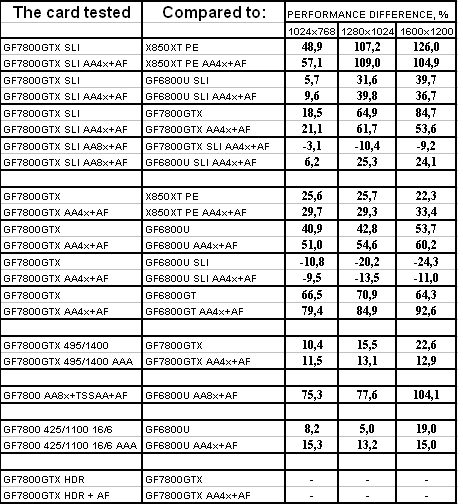 This test lost its importance for gamers long ago, but it is good at demonstrating video cards' capacities with relatively simple Pixel Shaders 2.0. When the GF6800U was launched, it demonstrated an imposing advantage over ATI's flagship of that time — Radeon 9800 XT. Then ATI released Radeon X800 series video cards and won back its leadership in this test. And now NVIDIA has taken back the palm from ATI. But we shall not be surprised if ATI R520 would return the status quo.
Game tests that heavily load vertex shaders, mixed pixel shaders 1.1 and 2.0, active multitexturing.FarCry, Research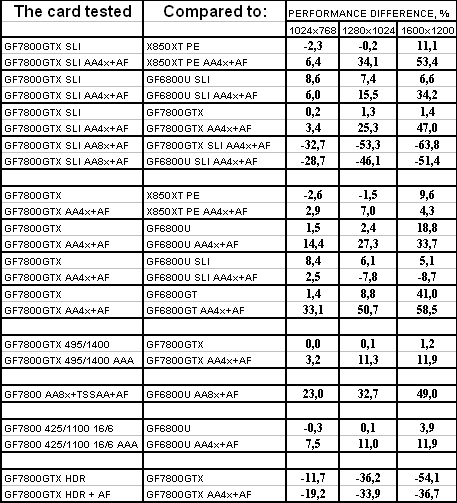 Performance of all video cards in modes without AA and AF is limited by a CPU. The same is true for the 1024x768 mode with AA and AF, real competition starts higher. The results show that the new video card from NVIDIA hardly manages the old ATI's flagship in this test — the 2 fps difference is scarcely a weighty advantage. On the other hand, the situation can be regarded from the opposite angle: the new video card from NVIDIA has outperformed the Radeon X850 XT PE as much as it has outperformed the GeForce 6800 Ultra! :-) Overclocked (as well as vanilla) GF7800GTX competes with a tandem of two GF6800U cards in this test. G70 SLI demonstrates maximum relative gain in the heaviest mode — 1600x1200 with AA and AF, which supports our assumption that the test is significantly limited by the CPU. We should also note that a Crossfire configuration with two Radeon X850 XT PE cards may turn out faster than two GeForce 7800 GTX cards in this test. Pay your attention to the result demonstrated by the GeForce 7800 GTX with enabled HDR (FP16 buffers with blending): the number of frames per second (fps) is quite playable up to the 1280x1024 mode with AF. I repeat that AA does not work with enabled HDR, so this result can be compared with the results of other cards only in terms of the choice "HDR+AF or AA+AF?" When HDR is activated together with AF, you can clearly see that the GF7800GTX demonstrates performance on the level with the GF6800GT with AA and AF. HDR activation drops fps at least by one third. It's better than in the NV45 (the drop with enabled HDR often exceeded 50%), but it's still too much to consider HDR mode "nearly free". FarCry, Regulator
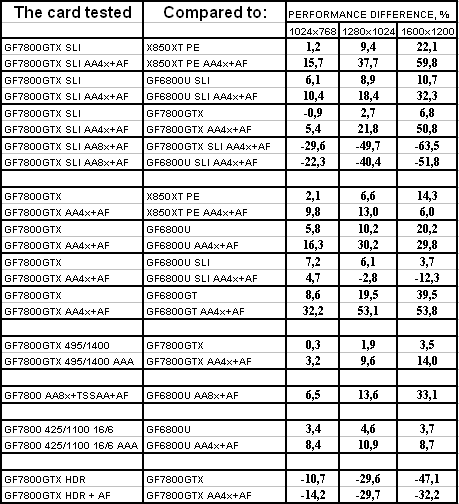
Test results on the Regulator level repeat the results obtained on the Research level. The GF7800GTX advantage over the RX850XTPE has become more pronounced and the pipeline performance gain in the G70 is demonstrated in all easy modes, not only at 600x1200.
FarCry, Pier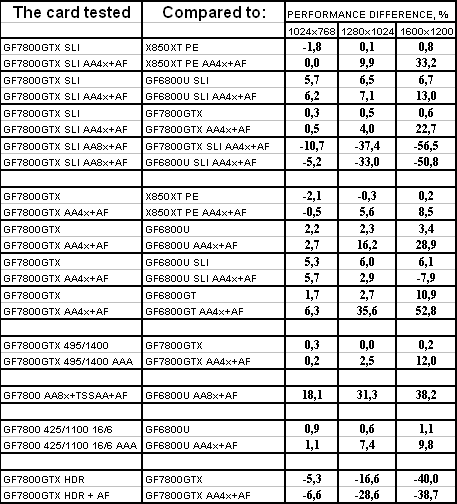 The results are meticulously similar to those on the Research level. But the SLI system consisting of two GF 7800 GTX cards is limited by the CPU even in 1600x1200 mode with AA and AF this time — performance on this level seems more dependent on the CPU.
Game tests that heavily load both vertex shaders and pixel shaders 2.0F.E.A.R. (MP beta)
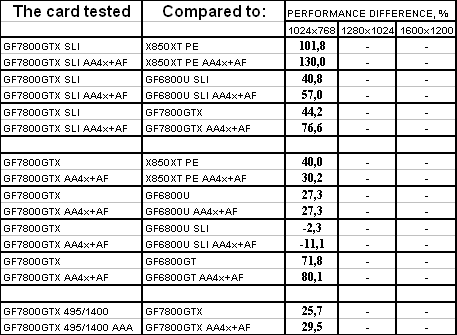 Forestalling your possible questions: due to time limits we tested the card only in 1024x768 mode. F.E.A.R. is the latest game, its release is planned for the autumn this year. It loads accelerators heavily, so the results are not so high in absolute FPS with maximum quality even without AA and AF. According to the results, you will need at least the Radeon X850 XT PE to play the game in 1024x768 with maximum graphics quality, the GeForce 7800 GTX is required for better comfort. Performance of the former top cards (RX850XTPE, GF6800U) is almost on a par, and the new card from NVIDIA outperforms them by one third, not a bad result for a latest game.
Half-Life2: ixbt01 demo
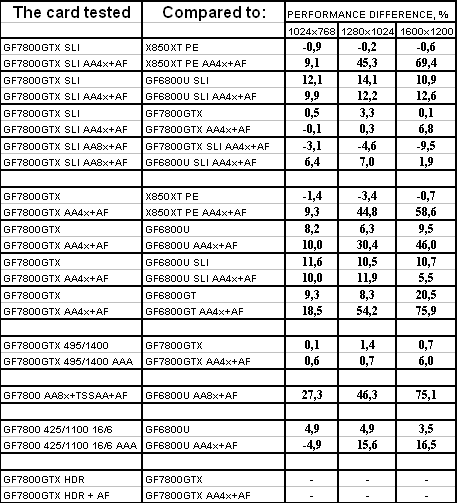 This test is limited by the CPU performance up to the 1280x1024 mode with AA and AF inclusive. But the capacity of the SLI system consisting of two G70 cards remains unclaimed even in 1600x1200 mode with AA and AF — we have to switch to AA 8x (and get 85.5 fps instead of 94.5 fps). Moreover, even a single GF7800GTX card provides playable fps with all bells and whistles enabled — AA 8x, AF 16x, gamma-correction, alpha textures anlialiasing! In this mega-quality mode the GF7800GTX offers 52 fps at 1600x1200. The competitor (Radeon X850 XT PE) is left far behind in the fog of history — the breakaway of the GF7800GTX from the Canadian flagship will grow with the increase of CPU capacities. But it's 58% in the heaviest mode anyway, it's an impressive result for a test, which traditionally preferred the Radeon architecture. And finally, let's note that the efficiency gain of the G70 chip compared to the NV45 is a nice surprise! — it grows together with the load on the video card, which is (unpleasant conclusion) absolutely natural, considering that this test is limited by the CPU performance in easy modes. Half-Life2: ixbt02 demo
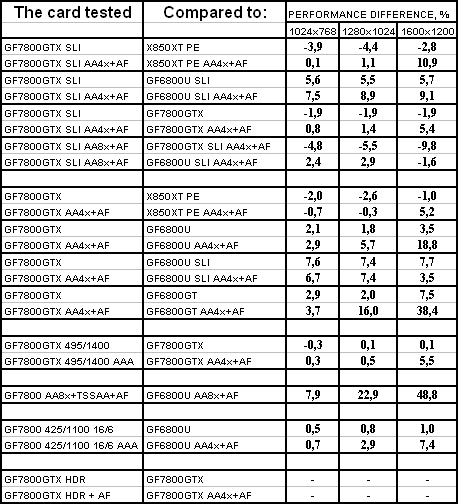 This test is more dependent on CPU performance than the previous one. It actually allows the Radeon X850 XT PE to catch up with the GF7800GTX, which stands idle most of the time waiting for the data from a CPU. As all main resources are limited by the CPU performance, it's high time that we draw your attention to the advantage of the GF7800GTX over the GF6800U in 1600x1200 Max Quality mode — with AF, AA 8x and, in case of the G70, gamma-correction and alpha texture antialiasing. It's not hard to notice that even with these bonuses (for example, alpha texture anlialiasing in HL2 comes quite in handy) the new flagship from NVIDIA outperforms the previous leader of the American company by almost 50% in 1600x1200. Half-Life2: ixbt03 demo
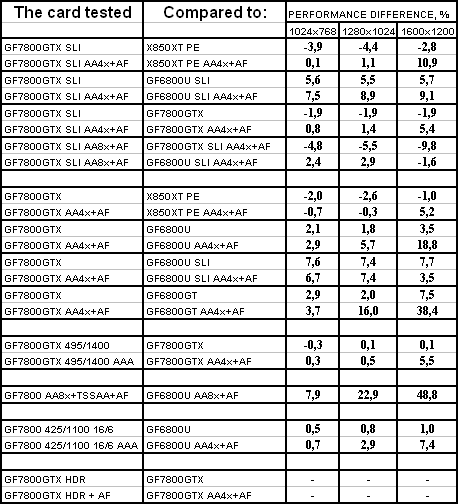 In fact, it's the only HL2 test that demonstrated noticeable gain from a SLI system based on the GF7800GTX — in 1600x1200 with AA/AF. Interestingly, the GF7800GTX does not outperform much the RX850XTPE in this mode, though the CPU limitation is out of the question. This test uses shaders, which Radeon chips are optimized for. This assumption is not that unlikely, considering how HL2 was released.
Game tests that heavily load pixel pipelines with texturing, active operations of the stencil buffer and shader unitsDOOM III High mode GeForce 7800 GTX outperforms the previous NVIDIA leader in heavy modes by only 15%, which can most likely be explained by the ROP configuration of the G70 chip. Such a result proves again that video cards' performance in Doom 3 depends much on Stencil Buffer performance — 15% performance gain in heavy modes is produced by the increased number of pipelines (from 16 to 24) and the same write capacity into a Z-buffer (32 results per cycle). A system with two GF7800GTX cards turns out limited by the CPU up to the 1600x1200 mode with AA and AF. Even the overclocked GF7800GTX cannot reach the performance level of the GF6800U SLI. This dismal situation (for the new video card from NVIDIA) is softened by the results of its competitor, which goes on a par with the GF6800GT, being weaker than the GF7800GTX by impressive 39.2% in the heaviest mode (1600x1200 with AA and AF). It's not a serious threat to the new GeForce family as well as to the previous generation in Doom 3 de facto. Chronicles of Riddick, demo 44
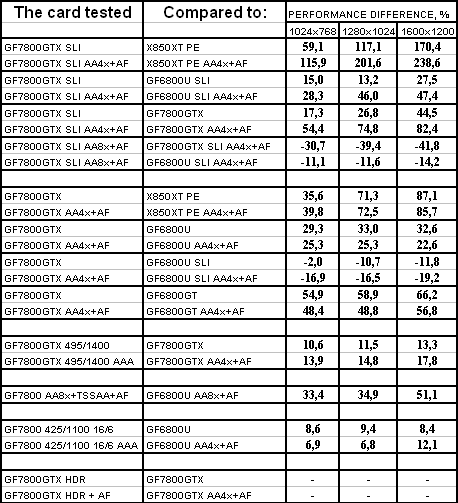 Performance in one of the most graphics-exacting games of the last year scales well almost in all modes and resolutions, except for 1024x768 without AA and AF — the new NVIDIA flagship is limited by the CPU performance here. The advantage of GeForce 7800 GTX over the previous NVIDIA top card (GeForce 6800 Ultra) reaches 33%. What is worse - this difference grows smaller with enabled AA and AF. The overclocked GF7800GTX is on a par with the GF6800U SLI. Performance of the GF7800GTX SLI is striking — such a tandem allows to play in modes with AA 8x and anisotropic filtering. The GF7800GTX with its characteristics reduced to the GF6800U level demonstrates an insignificant performance advantage, outperforming the previous NVIDIA's flagship by approximately 10%. Chronicles of Riddick, demo ducche
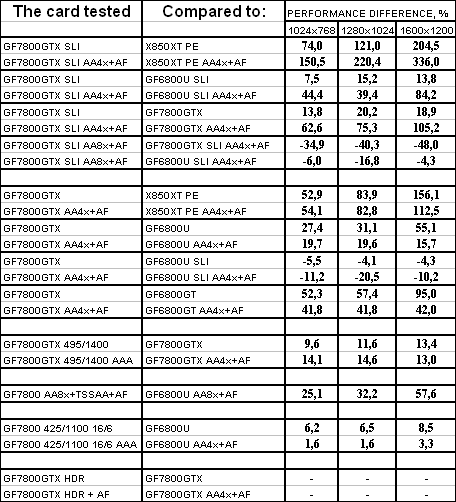 The breakaway between the new and the old NVIDIA flagships is noticeably smaller in this test (except for the 1600x1200 mode without AA and AF, where the GF7800GTX outperforms the GF6800U by 55%). This breakaway clearly grows smaller when AA and AF are enabled. A SLI system based on the GF7800GTX still copes well with AA 8x and anisotropic filtering. Pay your attention to the gain provided by the SLI system in 1600x1200 mode with AA and AF — for some mysterious reason two G70GTX cards are more than twice as fast as a single card, which is theoretically impossible, because the maximum gain from the second card cannot exceed 100%... G70, overclocked to 495 MHz, still competes well with the GF6800U SLI. The ATI flagship is constantly taking the last place, it even lags behind the GF6800GT, leaving no hopes for competition with the new NVIDIA flagship in this test even in case of Crossfire: the GF7800GTX advantage over the fastest ATI's card in this test reaches 156% — more than 2.5 times as fast! What concerns pipeline efficiency of the G70, it has grown by the same 5-10% (in the NV45 configuration) compared to the old flagship of the Californian company.
Synthetic tests that heavily load shader units3DMark05: MARKS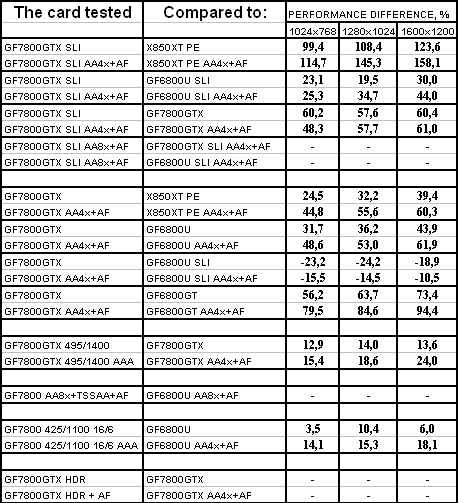 Overclocking results in noticeable gains even in 1024x768 mode without antialiasing and anisotropic filtering, which backs up the idea that the 3D Mark 05 performance is limited by the execution speed of pixel and vertex shaders in the first place. The gain relative to the previous NVIDIA flagship is significant but not huge. The highest performance gains in comparison with the GF6800U are registered in heavy modes — it's probably the effect of optimized caching for anisotropic filtering 16x. Besides, how much can NVIDIA increase 3D Mark 05 performance due to the new drivers remains an open matter. If you remember, the GF6800U initially demonstrated results that were lower by 2000 points in the standard mode (1024x768 without AA/AF).
Quality in the new AA modesYou have already read in the previous parts of this article that NVIDIA introduced additional AA modes for semitransparent textures, trying to meet gamers' demands and to repair typical MSAA drawbacks. It's no secret that, with all its advantages in terms of low performance requirements, multisampling (MSAA) has a drawback: antialiasing can be applied to objects with integral texturing, that is AA is actually available at the edges of these objects (to put it simply). But the latest texturing techniques more often allow developers to use a very efficient method: to draw openwork (like grids, foliage) on semitransparent (transparent) textures without wasting resources on sterling 3D models. Thus, as this openwork is within a single texture, MSAA ignores it. So foliage may look ugly (borderline "steps" will be striking) against nicely antialiased mountains or roofs. This problem can be solved by SSAA, but it requires too much resources, everyone knows that. Even now, when it's included into AA 8x, performance drops by three times, even in such a powerful accelerator as the 6800 Ultra (it sometimes drops gameplay below the tolerable level).
That's why NVIDIA developers came up with the idea to smooth out semitransparent textures: very good of them. There are two modes: MSAA and SSAA, you cannot choose their level. Of course, it works with the main AA type (2x, 4x, 8x). Let's see how it looks in FarCry (we chose a location between trees and came up close to one of them to examine the foliage, implemented with a semitransparent texture).
If you need more information regarding TAA, please read the additional Part 4 of the article linked below. NVIDIA GeForce 7800 GTX 256MB PCI-E
|
|
Article navigation: |
| blog comments powered by Disqus |
| Most Popular Reviews | More RSS |
 |
Comparing old, cheap solutions from AMD with new, budget offerings from Intel.
February 1, 2013 · Processor Roundups |
 |
Inno3D GeForce GTX 670 iChill, Inno3D GeForce GTX 660 Ti Graphics Cards A couple of mid-range adapters with original cooling systems.
January 30, 2013 · Video cards: NVIDIA GPUs |
 |
Creative Sound Blaster X-Fi Surround 5.1 An external X-Fi solution in tests.
September 9, 2008 · Sound Cards |
 |
The first worthwhile Piledriver CPU.
September 11, 2012 · Processors: AMD |
 |
Consumed Power, Energy Consumption: Ivy Bridge vs. Sandy Bridge Trying out the new method.
September 18, 2012 · Processors: Intel |
| Latest Reviews | More RSS |
 |
Retested all graphics cards with the new drivers.
Oct 18, 2013 · 3Digests
|
 |
Added new benchmarks: BioShock Infinite and Metro: Last Light.
Sep 06, 2013 · 3Digests
|
 |
Added the test results of NVIDIA GeForce GTX 760 and AMD Radeon HD 7730.
Aug 05, 2013 · 3Digests
|
 |
Gainward GeForce GTX 650 Ti BOOST 2GB Golden Sample Graphics Card An excellent hybrid of GeForce GTX 650 Ti and GeForce GTX 660.
Jun 24, 2013 · Video cards: NVIDIA GPUs
|
 |
Added the test results of NVIDIA GeForce GTX 770/780.
Jun 03, 2013 · 3Digests
|
| Latest News | More RSS |
Platform · Video · Multimedia · Mobile · Other || About us & Privacy policy · Twitter · Facebook
Copyright © Byrds Research & Publishing, Ltd., 1997–2011. All rights reserved.